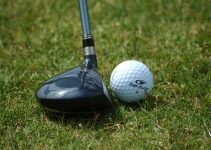Golfstead is reader-supported. When you buy through links on the site, we may earn an affiliate commission at no extra cost to you. Our affiliations include, but are not limited to, the eBay Partner Network and Amazon Associates.
When trying to maximize your distance and also make better contact with the golf ball, it’s important to generate some degree of lag.
Lag occurs when the clubhead is trailing behind the body near impact. The more your left wrist is hinged (for a right-handed golfer) at the point where your left arm is pointing just behind the ball in the downswing, the more lag you will generate and thus more power.
Lag generally leads to more clubhead speed since it preserves the energy that is stored in the backswing and leads to a “whip effect” that gives the clubhead an extra burst of speed right before impact.
How can you get more lag in your golf swing? It’s not something you will be able to change overnight, but here are some drills you can work on that should help you develop the proper feels associated with lag.
1. Short-Back Full-Down Drill
This drill is for golfers who want more lag in their swing.
The Procedure
The idea is to make a short backswing and then a full, quick downswing and follow-through. This will promote a “lag” in the club and allow you to develop the desired feel.
Start by making the backswing until your hands are at about waist height. Then turn your body aggressively through the downswing and let the club trail behind you, finishing high and full.
Think “explosive” to really generate a ton of lag.
The Goal
This drill will help you to develop the feeling of turning your body out of the way and delaying the release of the golf club — the recipe for lag.
Once you have ingrained the feeling, you can start to make fuller backswings and try to retain that “lag” feeling.
Just make sure that you’re hitting the ball solidly; no amount of lag in your swing will matter if you can’t make solid contact.
This drill is illustrated by PGA instructor Andy Proudman below:
2. The “Ear-To-Ear” Drill
This drill is for golfers who feel like their swing is too “armsy” and want to increase their lag angle for more power.
The Procedure
Keeping your hands just outside your body on the right (for a right-handed golfer), take the club back just ever so slightly and hinge your wrists so that the club shaft is nearly touching your ear.
Then swing through and release the club until your hands are just outside your body on the left and the club shaft is close to your other ear. This constitutes one repetition of the drill.
Keep a firm grip on the golf club but avoid gripping too tight.
The Goal
This drill will:
- teach you to “loosen” up your wrists without loosening your grip on the golf club
- help you develop the lag angle needed to increase the power and efficiency of your swing
- help you engage your lower body more and be less “armsy” in your swing
This is a long-term drill that ideally should be done for at least a few weeks. It usually takes about a month of practice to start seeing substantial results.
Not only can you incorporate this drill into your regular practice routine, but you can also do it virtually anywhere (in the house, etc.) at any time. You could do this drill 10-50 times per session or as much as you can.
If you’re in a room with a low ceiling, grip farther down on the club and proceed with the drill as normal.
Check out this demonstration of the drill with golf instructor Paul Wilson below:
3. The Baseball Bat Drill
This drill is for golfers who want more lag in their downswing and are familiar with how to swing a baseball bat.
The Procedure
With club in hand and standing straight up, make a baseball swing motion horizontally and stop when your hands are in front of the right side of your chest (for a right-handed golfer).
At this point, and assuming you have a general idea of how to swing a baseball bat, your right arm should be extended and the club should be angled about 90° from it.
Now tilt from your hips into a proper golf address position, and make the same “baseball bat” swing motion on the new tilted swing plane.
The Goal
What a lot of people don’t realize is the swing of a baseball bat and a golf swing are essentially the same aside from the swing planes involved. If you know how to swing a baseball bat with decent form (which many people find rather easy), it’s really just a matter of making that same motion on a tilted plane with a golf club.
The 90° angle produced in the baseball swing represents the very lag that you want to carry over to the golf swing.
In summary, it can be very helpful to imagine that you’re swinging a baseball bat on a tilted plane when making your golf swing.
Below, golf instructor Clay Ballard demonstrates this drill and also gives some related tips:
4. The “Neck” Drill
This drill is for golfers who tend to lock up their arms during the swing and thus prevent themselves from generating lag.
The Procedure
Set up behind the ball normally with a wood or iron. Take the club all the way back, and break your lead arm and hinge your wrist so that the club ends up “resting” on top of your neck and is roughly parallel to the ground.
From this relaxed position at the top of the backswing, come down into the ball and hit the shot.
You should find that your body rotates naturally through the shot, but more importantly, you maintain a greater angle between the left forearm and the club which is the definition of lag.
As a result, you’ll probably notice that your shots are going straighter and longer with less effort than normal.
The Goal
The goal of this drill is to promote relaxation of the arms and wrists during the swing so that you’re not tense and “locked up”. As a result, you’ll naturally develop a lag angle that will be maintained in the downswing.
Once you get used to the motion in the backswing of “touching your neck”, the next step should be to not break your lead arm quite as much.
Take the club back to parallel or near parallel, but keep it a few inches above your neck, and make your downswing. Do this until you get used to the feeling of maintaining lag in the downswing. Eventually, you can build up towards making a proper backswing with your lead arm extended as much as possible.
Golf instructor Paul Wilson walks you through this drill in detail here:
Conclusion
Being able to generate lag in the golf swing is just one thing that separates hackers that can’t break 100 from golf’s finest. If you can develop lag, you’ll be well-positioned to take your game to the next level.
Try some of these drills, be persistent, and hopefully you’ll be able to see some positive results! For more speed, try these other drills.
Also remember that having quality equipment (clubs, training aids, etc.) will help lift up your entire game so that it’s even easier for you to generate lag in the swing.
Have you tried any of these drills? What have your results been? Let us know in the comments below.


